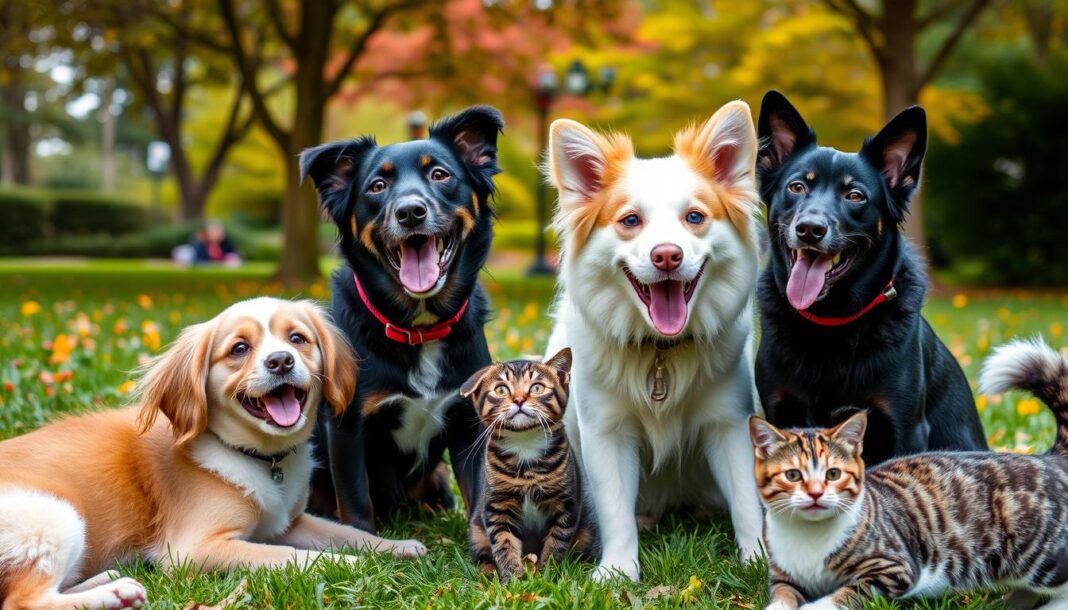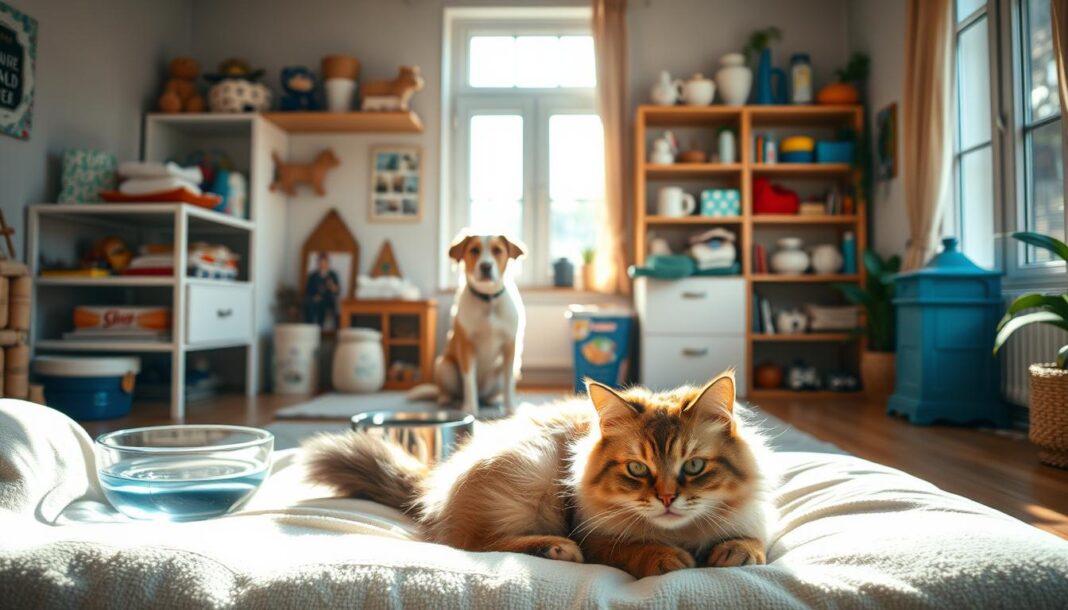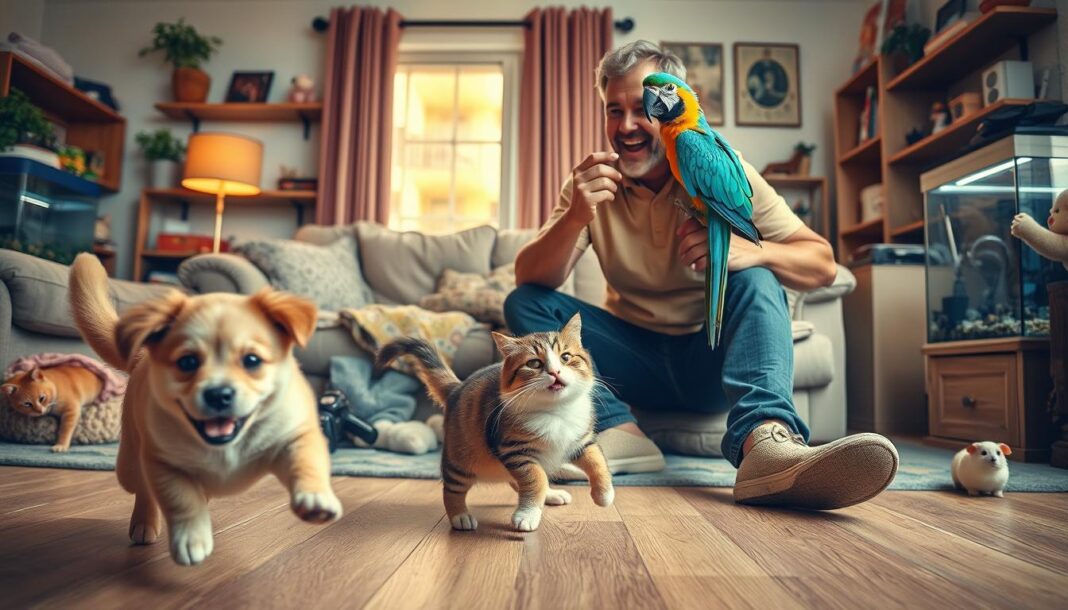Have you ever noticed how having a pet can bring people together? Animals in our lives can deeply affect our relationships and happiness. The 2017–18 National Pet Owners Survey by the American Pet Products Association (APPA) found that 68% of US households own a pet. This means 84.6 million homes have pets.
The human-animal bond is complex and touches many parts of our lives. It affects our romantic relationships and family dynamics. As we dive deeper, we’ll look at the science behind this bond. We’ll see how pet ownership shapes our relationships.
The Science Behind Human-Animal Bonds
The bond between humans and animals has a long history. It has changed from a practical relationship to a deep emotional one. You might wonder how this change happened.
Evolutionary Perspective on Pet Ownership
Domesticating animals was a big change in human-animal relationships. At first, animals were kept for tasks like hunting and farming.
From Working Animals to Companions
As time went on, animals became more than just workers. They became part of families, becoming companions. This shows how the bond between humans and animals grew stronger.
The science behind the bond between humans and animals is complex. Studies show that both humans and animals feel emotions towards each other. They release oxytocin, known as the “love hormone,” during these moments. This hormone plays a big role in forming a strong bond between them.
Learning about the science behind this bond helps us understand why humans and animals connect so deeply. This connection is not just emotional but also has a physical basis.
Pets and Romantic Relationships: Matchmakers or Deal-Breakers?
Pets can greatly affect romantic relationships. They can bring partners closer or cause tension. It all depends on how pets are involved.
How Pets Influence Dating Decisions
Pets are often seen as family members. This means their needs are considered when dating. It’s a big factor in choosing a partner.
Dating App Dynamics and Pet Photos
Pet photos are common on dating apps. A pet photo can show a softer side and attract matches. But, too many photos might not be good.
Meeting a partner for the first time with pets can be tricky. A well-behaved pet can impress. But, an energetic or aggressive pet might not.
| Pet Influence | Positive Impact | Negative Impact |
|---|---|---|
| Dating App Profiles | Humanizes the profile | Overemphasis on pets |
| First Impressions | Conversation starter | Awkward interactions |
Many pet owners treat their pets like family. 70% sleep with their pets, and 65% buy them Christmas gifts. Married women often find more emotional support in pets than their spouses. This shows pets’ big role in our lives and how they can affect our relationships.
Knowing how pets influence dating can help in relationships. Whether you have pets or not, being aware of their impact is key. It can change how you approach love.
Furry Family Members: Pets in Household Dynamics
Pets are becoming more than just pets; they’re part of the family. They change how we live, interact, and even parent. As a pet owner, you’ll notice these changes in your daily life.
Pets as Practice for Parenthood
Many families see pets as a step towards having kids. They teach about responsibility and caring for another life. Caring for a pet helps you learn how to be a parent, like feeding and emotional support.
Shared Responsibility Testing
Pets help families work together. They make everyone share in the care, building teamwork and unity. This way, everyone learns to work as a team.
Nurturing Instincts and Expression
Pets let us show love and care in special ways. Studies show they can lower stress and make us feel happier. This is good for our family’s mood and health.
| Benefits of Pets in Household Dynamics | Description |
|---|---|
| Promotes Shared Responsibility | Dividing pet care tasks among household members fosters unity and cooperation. |
| Nurturing Instincts | Pets provide an outlet for expressing love and care, promoting emotional well-being. |
| Reduces Stress | Interacting with pets has been shown to lower blood pressure and reduce stress levels. |
Understanding pets’ role in our homes helps us see their value. They add to our family’s happiness and strengthen our bonds.
Children and Pets: Developing Empathy and Responsibility
Having pets can change a child’s life, teaching them important skills. These skills go beyond just pet care. As a parent, you know the many benefits of raising a pet-friendly child.
Pets help children develop empathy. Research shows kids with pets have better social skills and empathy. Caring for a pet teaches them to understand and meet another living being’s needs.
Age-Appropriate Pet Interactions
It’s important to think about your child’s age when introducing them to pets. Supervision is key for a safe and positive experience for both kids and pets.
Safety Guidelines by Child Development Stage
| Child Development Stage | Safety Guidelines |
|---|---|
| Infants (0-12 months) | Keep pets away from infants, as they may not understand how to interact gently. |
| Toddlers (1-3 years) | Supervise interactions closely, teaching toddlers how to pet animals gently. |
| Preschoolers (3-5 years) | Encourage children to help with simple pet care tasks, like refilling food or water. |
Matching Pets to Children’s Capabilities
When picking a pet, think about your child’s age, abilities, and personality. Some pets need more care than others. It’s important to choose a pet that fits your child’s level of responsibility.
By introducing pets to your children and teaching them pet care, you’re teaching them important life skills. These skills include responsibility and compassion. As your child grows, they can take on more pet care tasks, strengthening these valuable traits.
Pets and Relationships: How Animals Affect Human Bonds
Pets have a special way of bringing people together. They help create a sense of community and social bonding among their owners. This is clear in how pets help people meet and connect with each other.
The Role of Pets as Social Facilitators
Pets, like dogs, are key in helping people connect. Dog parks and pet-friendly public spaces are places where people meet. These spots are perfect for starting conversations and making friends.
Dog Parks and Community Building
Dog parks are great examples of how pets build communities. They let dog owners meet and socialize. While watching their dogs play, owners talk to each other, sharing tips and making friends.
Pets as Conversation Starters
Pets can start conversations in many places. Their unique looks or behaviors can spark interest and conversation. This helps people who find it hard to start talking or connect with others.
Pet-friendly places like pet stores, vet clinics, and dog daycare are also social spots. They offer chances for owners to meet and talk, showing pets’ role in socializing people.
Seeing how pets unite us helps us understand their big impact on our social lives and communities.
The Therapeutic Power of Pets in Relationships
Pets can greatly help in building strong emotional bonds in relationships. They are now a big part of many families, offering love and support. Research is showing how pets can help in relationships, focusing on emotional support animals and therapy animals.
Distinctions Between Emotional Support and Therapy Animals
Emotional support animals and therapy animals offer different kinds of help. Emotional support animals give comfort and companionship to those with mental or emotional issues. Therapy animals, trained to give affection, help many people in places like hospitals and schools.
Legal Distinctions and Protections
Emotional support animals are protected by laws, allowing them in homes and on flights. Therapy animals, though not legally protected the same way, are valued in therapy programs.
Training and Certification Requirements
Therapy animals need special training and certification. This includes learning obedience and social skills. Emotional support animals don’t need training but must be recommended by a mental health professional.
Pets bring many benefits to human relationships. They offer comfort, help people meet others, and support mental health. For example, they can:
- Provide emotional comfort and companionship
- Facilitate social interactions and connections
- Support mental health and well-being
Knowing the differences between emotional support and therapy animals helps us see their unique benefits. They play a big role in supporting human well-being in relationships.
Key Takeaways:
- Emotional support animals provide comfort and companionship to individuals with mental or emotional disabilities.
- Therapy animals are trained to provide affection and comfort to multiple individuals in various settings.
- Understanding the legal distinctions and training requirements for emotional support and therapy animals is crucial for harnessing their therapeutic potential.
When Pets Cause Relationship Strain
Pet ownership brings love and companionship, but also big financial costs. These costs can put a strain on your relationship. If not managed well, they can cause tension between partners.
Financial Stressors of Pet Ownership
There are many expenses with pet ownership, like food, grooming, and vet care. Unexpected veterinary costs can be hard to handle. They can be high and come out of nowhere, like emergency surgeries or chronic conditions.
Unexpected Veterinary Costs
Dealing with sudden pet illnesses or injuries can be a big surprise. These unforeseen expenses can hurt your budget. They can also cause problems in your relationship if not planned for.
Budgeting for Pet Expenses as a Couple
It’s important for couples to budget effectively for pet costs. Set aside money each month for regular expenses. Also, have an emergency fund for vet bills. This can help reduce financial stress on your relationship.
Talking openly about pet expenses and planning can ease financial stress. Working together, you and your partner can meet your pet’s needs without harming your relationship.
Navigating Pet Loss as a Couple or Family
When a pet dies, it’s tough for couples and families. They need empathy and understanding. Losing a pet is a big event that touches people in different ways. It’s important for partners to support each other.
Different Grieving Styles for Pet Loss
People grieve in many ways, and pet loss is no different. Some feel deep pain, while others might seem calm. It’s key to know these grieving styles to offer the right support.
Recognizing Grief Expressions in Partners
Understanding how your partner shows grief is crucial. Some might pull back, while others might get more emotional or upset. By recognizing these expressions, you can support them better.
Supporting Without Judgment
Supporting your partner without judgment is vital. Don’t downplay their feelings or compare them to yours. Just be there and offer comfort in ways that mean something to both of you.
Navigating pet loss as a couple or family needs patience, understanding, and open talk. By acknowledging different grieving ways and supporting each other, you can grow closer during tough times.
For more on dealing with pet loss, look into pet loss support groups or counseling. They can offer extra help and guidance.
Different Pets, Different Relationship Effects
Pets can greatly affect our relationships. The type of pet you have can change how you connect with others. It also shapes how you see the world.
Dogs: The Social Connectors
Dogs are seen as social connectors. They help people meet and build friendships. This happens at dog parks, pet stores, or just walking around.
Breed-Specific Relationship Influences
The breed of dog you have can also impact your relationships. For instance, owning a Labrador or Golden Retriever can make it easier to talk to other dog owners. These breeds are known for being friendly.
Activity-Based Bonding Opportunities
Doing activities with your dog, like agility training or hiking, can bond you closer. It can also strengthen relationships with others who have dogs. These shared experiences create common interests and memories.
Seeing dogs as social connectors helps us understand their impact on our relationships. By recognizing how dogs influence our social lives, we can use this to build stronger bonds with others.
Digital Age Pet Relationships: Social Media and Beyond
As you explore the digital world, your pet’s online life can change your relationships. The digital age has changed how we connect with our pets and each other. It has made our bonds with animals stronger.
Pet Influencers and Relationship Dynamics
Social media has made pet influencers famous, with many pets becoming stars on Instagram. These pets can help their owners meet others with similar interests. This can make relationships stronger.
Creating content with your pet can be fun for everyone involved. It can bring people together, encouraging teamwork and creativity. Working on pet-related projects can strengthen bonds and create lasting memories.
Privacy and Boundary Setting
But, it’s important to think about privacy and setting boundaries when sharing your pet’s life online. You should balance sharing your pet’s charm with protecting their privacy. Setting limits on what you share can keep relationships healthy, both online and offline.
Being careful about your pet’s online presence can help you enjoy social media’s benefits. It also keeps your personal life balanced.
Cultural Perspectives on Pets and Human Relationships
Cultural views on pets vary a lot, shaping how we treat our animals. Our cultural background and values about animal companionship show in how we care for pets.
Cross-Cultural Variations in Pet-Human Bonds
The bond between humans and animals differs across cultures. In some places, pets are seen as working animals. In others, they’re loved family members. This changes how pets are treated and included in family life.
Working Animals vs. Companion Animals
In many cultures, animals help with tasks like herding or guarding. But in some, pets are seen as friends, offering love and support. For example, in Western cultures, dogs are often seen as family. In other cultures, they’re mainly for work.
| Cultural View | Role of Pets | Care and Interaction |
|---|---|---|
| Western Cultures | Companion Animals | High emotional involvement, treated as family members |
| Some Indigenous Cultures | Spiritual or Working Animals | Respected for their roles, may be treated with spiritual significance |
Religious and Traditional Influences
Religion and tradition also shape pet-human bonds. For example, some religions have rules about animal care. These rules affect how pets are treated in those cultures.
Learning about these cultural views can deepen our understanding of pets in human lives. By seeing how culture influences pet bonds, we can appreciate the rich and varied nature of these relationships.
Ethical Considerations in Pet-Human Relationships
Understanding pet-human relationships is key. We must look at the ethics behind these bonds. Our actions towards pets are shaped by many things, like seeing animals as human-like.
Anthropomorphism: Benefits and Drawbacks
Seeing animals as human can be good or bad. It can make our bond with pets stronger by helping us feel empathy and understanding.
When Humanization Helps Connection
Seeing pets as human-like helps us connect on a deeper level. It makes it easier to meet their needs. For example, knowing how a pet feels helps us comfort them better.
When It Leads to Misunderstanding Animal Needs
But, seeing animals as human can also cause problems. It can make us misunderstand their true needs and behaviors. For instance, thinking pets have the same emotional needs as humans can lead to wrong care.
Pet owners need to understand these points. This way, we can enjoy the benefits of seeing animals as human-like while still knowing their real needs.
Future Trends in Human-Animal Relationships
As we look ahead, human-animal relationships are set to change a lot. This is because of changes in who we are and how we live. These changes will affect how we connect with animals.
Changing Demographics and Pet Ownership
How we live, work, and care for pets is changing. With more older people and different family setups, pet ownership is shifting. This will change how we bond with animals.
Pets as Children Substitutes
Some people see pets as a stand-in for kids. This is common among young adults and couples who are waiting to have children.
Aging Population and Companion Animals
The number of older people is growing. As we age, we often turn to pets for support and friendship.
| Demographic Factor | Impact on Pet Ownership | Effect on Human-Animal Bond |
|---|---|---|
| Aging Population | Increased demand for companion animals | Stronger emotional bonds |
| Changing Family Structures | More singles and couples without children owning pets | Pets become integral family members |
| Urbanization | Shift towards smaller, low-maintenance pets | Adaptation in pet care and interaction |
Understanding these trends helps us get ready for the future of human-animal connections. By seeing how demographics change, we can better handle pet ownership and its impact on our relationships with animals.
Conclusion
The bond between humans and pets is complex and deep. It affects our romantic lives, family ties, and our own happiness. Learning about this bond helps us see how pets enrich our relationships.
Having pets can be very rewarding. They teach kids empathy and responsibility. They also offer emotional support and friendship. Understanding these roles helps us value pets more in our lives.
As we look ahead, studying human-animal connections is key. It helps us see how pets improve our society and culture. By embracing this bond, we can make our relationships stronger and our community kinder.



